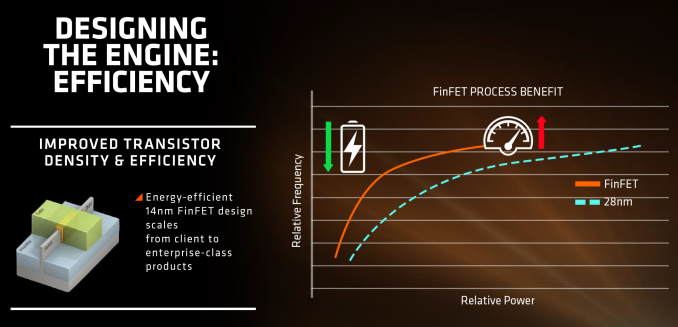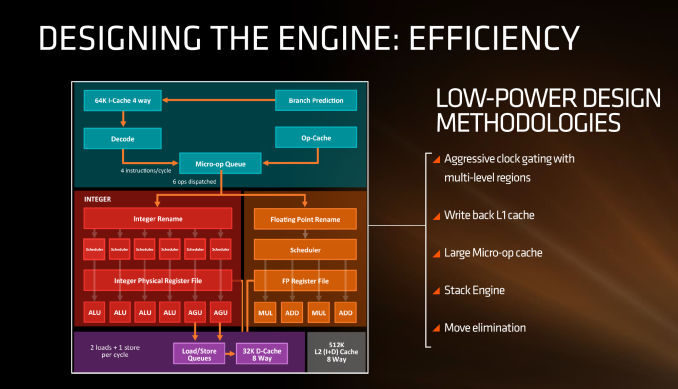AMD Zen Microarchitecture: Dual Schedulers, Micro-Op Cache and Memory Hierarchy Revealed
by Ian Cutress on August 18, 2016 9:00 AM ESTLow Power, FinFET and Clock Gating
When AMD launched Carrizo and Bristol Ridge for notebooks, one of the big stories was how AMD had implemented a number of techniques to improve power consumption and subsequently increase efficiency. A number of those lessons have come through with Zen, as well as a few new aspects in play due to the lithography.
First up is the FinFET effect. Regular readers of AnandTech and those that follow the industry will already be bored to death with FinFET, but the design allows for a lower power version of a transistor at a given frequency. Now of course everyone using FinFET can have a different implementation which gives specific power/performance characteristics, but Zen on the 14nm FinFET process at Global Foundries is already a known quantity with AMD’s Polaris GPUs which are built similarly. The combination of FinFET with the fact that AMD confirmed that they will be using the density-optimised version of 14nm FinFET (which will allow for smaller die sizes and more reasonable efficiency points) also contributes to a shift of either higher performance at the same power or the same performance at lower power.
AMD stated in the brief that power consumption and efficiency was constantly drilled into the engineers, and as explained in previous briefings, there ends up being a tradeoff between performance and efficiency about what can be done for a number of elements of the core (e.g. 1% performance might cost 2% efficiency). For Zen, the micro-op cache will save power by not having to go further out to get instruction data, improved prefetch and a couple of other features such as move elimination will also reduce the work, but AMD also states that cores will be aggressively clock gated to improve efficiency.
We saw with AMD’s 7th Gen APUs that power gating was also a target with that design, especially when remaining at the best efficiency point (given specific performance) is usually the best policy. The way the diagram above is laid out would seem to suggest that different parts of the core could independently be clock gated depending on use (e.g. decode vs FP ports), although we were not able to confirm if this is the case. It also relies on having very quick (1-2 cycle) clock gating implementations, and note that clock gating is different to power-gating, which is harder to implement.












216 Comments
View All Comments
willis936 - Thursday, August 18, 2016 - link
I thought the zen hype was all noise but if they're actually doing what they're claiming they may make up a lot of ground here.BrokenCrayons - Thursday, August 18, 2016 - link
I'd be cautious about that. If AMD was expecting to be extremely competitive, I think the company would be keeping a closer hold on architectural details so as to catch Intel more by surprise. Instead, they're leaning more toward full disclosure which means they're looking to build hype with consumers. One could read into that openness as a harbinger of a mediocre product launch for which Intel might already be well-prepared to meet.And if that's true, I'd be disappointed. We need a more competitive market to kick things along a little even if it won't last for very long thanks to the ever-increasing difficulty in developing smaller transistors.
nandnandnand - Thursday, August 18, 2016 - link
Zen is getting a one time massive boost in IPC due to correcting the failed architecture.The scientists and engineers working at AMD aren't high school dropouts. It's not crazy to think that they can put out something 75-90% as good as Intel, and undercut them on price. Namely because Moore's law is almost dead and Intel has stalled out, delaying 10nm by a year. Let's see 14nm vs. 14nm. The ever-increasing difficulty in developing smaller transistors works to AMD's benefit.
wumpus - Thursday, August 18, 2016 - link
One thing to remember is that GoFlo can't supply more than 10% of the marketshare. Even during AMD's glory days when Intel was floundering with Pentium4 and the Itanic disaster, there simply was no way to take over the market due to the simply inability to supply enough chips (which Intel was able to exploit with exclusive deals to the likes of Dell).Now with no chance of meeting, let alone exceeding the power of Intel (who has vastly more smart guys who have been literally refining this overall architecture for more than 10 years (the current uarch might not be the same as core2, but it is vastly more similar than Zen is to Bulldozer). AMD's only real chance is to find some niche they can beat Intel at, and convince the customers that want it to buy AMD (and yes, the latter is often harder than the former).
Obviously, it looks like AMD is going for the full-thread power. The catch is that *everybody* looks at full-thread power (IBM Power and any competition popping up from the ARM world), so Intel has probably spent more R&D researching how to combat that than AMD spent making the Zen. Intel already wastes enough transistors in the more expensive chips on built-in graphics (chips that will *never* use it considering the relative cost of a GPU to the CPU itself), so they can easily add more cores (which will improve benchmarks and presumably decrease AMD sales, even if they do almost nothing else in the real world than those unused graphics).
Of course, Intel seems to have hit a 10 year plateau (possibly through AMD's, IBM's and ARM's complete inability to compete*). They should certainly not be as surprised by any Intel counters as they may have been with the 1060.
* It must be said that Intel finally admitted that while ARM can't eat Intel's lunch, they can't eat ARM's lunch either. If only this was true for AMD.
mdriftmeyer - Thursday, August 18, 2016 - link
Samsung and GloFo share the same 14nm process, so yes they can provide > 10% of the market.Nagorak - Thursday, August 18, 2016 - link
There are diminishing returns on everything. Having ten times as many "smart people" maybe gives you a 10-20% advantage. AMD can see what worked for Intel and basically reverse engineer it too. The process disadvantage has been pretty much narrowed. It would not surprise me if Zen was competitive with Intel at this point.I'm not sure that I agree with Intel's decision to give up on mobile. Sure they haven't made much headway, but it made sense they were going after it, and I don't think just throwing in the towel was necessarily the right thing to do.
BrokenCrayons - Friday, August 19, 2016 - link
Reverse engineering Intel products and then incorporating those technologies into new AMD products would cause AMD to ALWAYS remain behind Intel because of the latency between reverse engineering and production. To get into that sort of a situation means AMD would never achieve a technological parity or be in a position to rise above the competition. In a competitive market, that's a path to bankruptcy and nothing else. In order to survive, AMD must be innovative, nimble, and aggressive.Kevin G - Saturday, August 20, 2016 - link
If AMD becomes popular again, they can port the design to TSMC for additional volume. They do have a minimum order agreement with GloFo but it isn't truly exclusive.FMinus - Thursday, August 18, 2016 - link
When we get to now the details of an architecture, the competition already knows about it two years ago. There's no point being quiet.jardows2 - Friday, August 19, 2016 - link
I'm not so sure about that. It's not like the GPU market where there is lots of fluidity in the technology. Intel is pretty much locked in for features/improvements for the next few years. A few details about their competitor, coming this close to release, isn't going to change anything Intel does. It's not like Intel is in the position to radically redesign Kaby Lake or Cannon Lake, and after that is so far out that it is irrelevant to Zen's launch.I think AMD is doing a smart move by releasing more details. Perhaps they feel the sting of hyping up Bulldozer so much, but releasing few details, and getting trashed in real-world performance. For Zen, release more details so the hype doesn't dwarf the reality, and give people the desire to purchase the product.